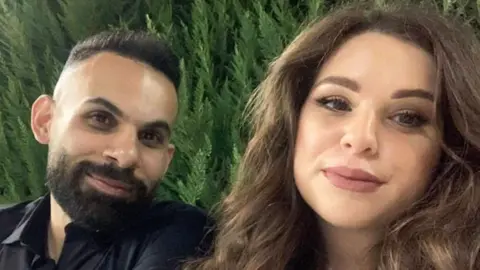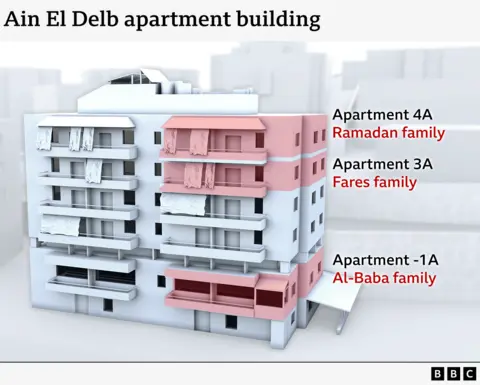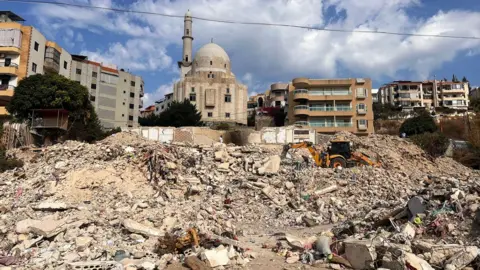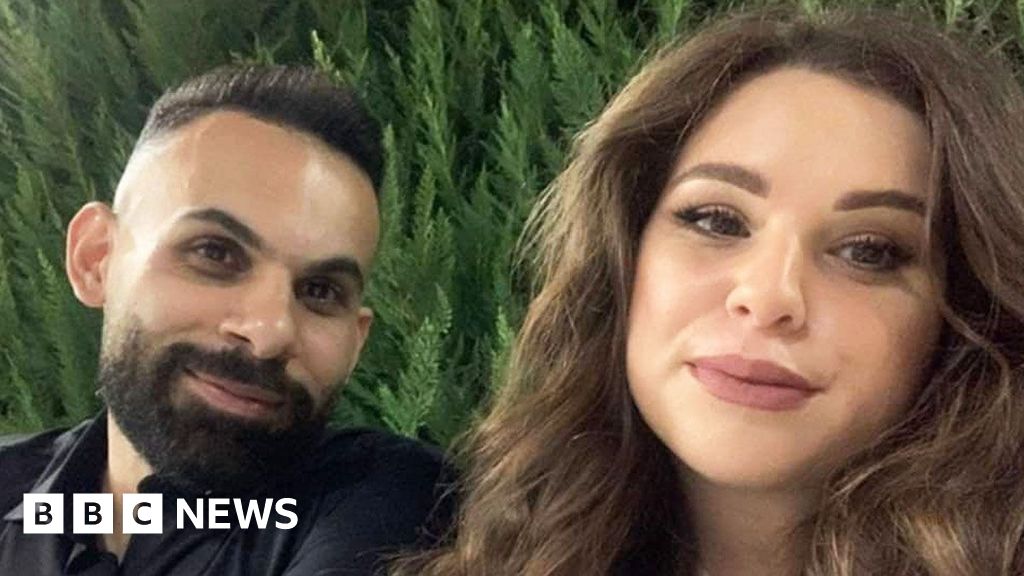Senior International Investigation Correspondent, BBC World Service
 BBC
BBCJulia Ramadan was scared – the war between Israel and Hezbollah escalated, and she had had a nightmare that her family home was bombing. When she sent her brother a panic voice message from his apartment in Beirut, he urged her to join him in Ain El Delb, a sleepy village in southern Lebanon.
“It’s probably here,” he reassured her. “Come and stay with us until things are deleted.”
Earlier, the month, Israel intensified air campaigns against Hezbollah in Lebanon in response to escalating rocket attacks from the Iran-backed armed group that had killed civilians and displaced tens of thousands more from homes in northern Israel.
Ashraf was convinced that their family’s apartment block would be a refuge, so Julia joined him. But the next day, September 29, it was subject to this conflict’s deadliest single Israeli attacks. Strained by Israeli missiles, the entire six -storey building collapsed and killed 73 people.
Israel Defense Forces (IDF) says the building was targeted because it was a Hezbollah “Terrorist Command Center” and it “eliminated” a Hizbollah commander. It added that “the overwhelming majority” of those killed in the strike were “confirmed to be terrorist operatives”.
But a BBC eye survey verified the identity of 68 of the 73 killed in the attack and uncovered evidence suggesting that only six were linked to Hezbollah’s military wing. None of those we identified seemed to have a senior rig. The BBC’s World Service also found that the other 62 were civil – 23 of them children.
Among the dead, babies were just a few months old, like Nouh Kobeissi in apartment -2b. In apartment -1c, schoolteacher Abeer Hallak was killed with her husband and three sons. Three floors above, Amal Hakawati died with three generations of her family – her husband, children and two childbirths.

Ashraf and Julia had always been close to sharing everything with each other. “She was like a black box and kept all my secrets,” he says.
In the afternoon of September 29, the siblings had just returned from handing out food to families who had fled from the matches. Hundreds of thousands of people in Lebanon had been displaced by the war.
Ashraf was in the shower and Julia was sitting in the living room with their father and helping him upload a video to social media. Their mother, Janan, was in the kitchen and cleaned up.
Then, without warning, they heard a deafening smell. The whole building was shaking and a massive cloud of dust and smoke is poured into their apartment.
“I shouted,” Julia! Julia!, ”Says Ashraf.
“She replied, ‘I’m here.’
“I looked at my dad who struggled to get up from the couch because of an existing injury to his leg and saw my mother running against the front door.”
Julia’s nightmare played in real life.
“Julia was hyperventilating and cried so hard on the couch. I tried to reassure her and told her we had to get out. Then there was another attack.”
Video footage of the strike, shared online and verified by the BBC, reveals four Israeli missiles flying through the air towards the building. Seconds later, the block collapses.
Ashraf along with many others were caught under the rubble. He started calling, but the only voice he could hear was by his father who told him he could still hear Julia and that she was alive. None of them could hear Ashraf’s mother.
Ashraf sent a voice note to friends in the neighborhood to warn them. The next few hours were annoying. He could hear rescuers aiming through the waste – and the residents cried as they discovered dear dead. “I was just thinking, thank you, not Julia. I can’t live this life without Julia.”
Ashraf was finally pulled from the rubble later, with only minor damage.
He discovered that his mother had been rescued but died in the hospital. Julia was suffocated under the rubble. His father later told him that Julia’s last words were calls for her brother.

In November, a ceasefire agreement was agreed between Israel and Hezbollah for the purpose of ending the conflict. The deal gives a 60-day deadline for Israeli forces to withdraw from southern Lebanon and for Hezbollah to withdraw his forces and weapons north of the Litani River. As this deadline January 26 is approaching, we tried to find out more about the deadliest single Israeli attacks on Lebanon this year.
In the apartment below, Julia and Ashraf’s Hawraa and Ali Fares had hosted family members who were displaced by the war. Among them was Hawraa’s sister Batoul, who, like Julia, had arrived the previous day – with her husband and two young children. They had fled with intense bombardment near the border with Lebanon-Israel, in areas where Hezbollah has a strong presence.
“We hesitated where we’re going,” says Batoul. “And then I said to my husband, ‘Let’s go to Ain El Delb. My sister said their building was safe and that they couldn’t hear any bombing nearby.'”
Batoul’s husband Mohammed Fares was killed in the Ain El Delb attack. A pillar fell on batoul and her children. She says no one responded to her calls for help. She finally managed to lift it alone, but her four -year -old daughter Hawraa had been fatally crushed. Miraculously, her baby survived Malak.
 Father’s family
Father’s familyThree floors under Batoul lived Denise and Moheyaldeen al-Baba. On Sunday, Denise had invited his brother Hisham for lunch.
The effect of the strike was brutal, says Hisham.
“The other missile threw me on the floor … The whole wall fell on top of me.”
He spent seven hours under the rubble.
“I heard a voice far away. People were talking. Scream and … ‘Cover her. Remove her. Lift the stone. He’s still alive. It’s a child. Lift this child.’ I mean … oh my god.
When Hisham was finally rescued, he found his niese fiancé waiting to hear if she was alive. He lied to him and told him she was doing well. They found her body three days later.
Hisham lost four members of his family-his sister, brother-in-law and their two children. He told us that he had lost his faith and no longer believes in God.
To find out more about who died, we have analyzed Lebanese Ministry of Health Data, Videos, Social Media Posts and talking to survivors from the attack.
In particular, we wanted to inquire IDF’s response to media – immediately after the attack – that the residential block had been a Hezbollah command center. We asked IDF several times what constituted a command center, but it did not clarify.
So we began to silence through social media tribute, gravesites, public health registers and videos of funerals to determine if they killed the attack had any military attachment to Hezbollah.
We could only find evidence that six of the 68 dead we identified were associated with Hezbollah’s military wing.
Hezbollah memorial photos for the six men use the label “Mujahid”, which means “fighter”. Senior figures, on the other hand, are called “QAID”, which means “commander” – and we found no such labels used by the group to describe the killers.
We asked IDF if the six Hezbollah warriors we identified were the intended goals of the strike. It did not answer this question.

One of the Hezbollah warriors we identified was Batoul’s husband, Mohammed Fares. Batoul told us that her husband, like many other men in southern Lebanon, was a reservist for the group, though she added that he had never been paid by Hezbollah, held a formal rank or participated in battle.
Israel sees Hezbollah as one of its greatest threats, and the group is appointed to a terrorist organization of Israel, many Western governments and Gulf -Arab states.
But next to his large, well -armed military wing, Hezbollah is also an influential political party that holds seats in the Lebanese parliament. In many parts of the country, it is woven into the social substance that provides a network of social services.
In response to our study, IDF said the relationship with the military advantage expected from the strike. “
The BBC had also told the BBC that it had performed “evacuation procedures” for the strike at Ain El Delb, but everyone we spoke to said they had not received any warning.
FN experts have raised concern for The proportionality and necessity of Israeli air strikes on residential buildings in densely populated areas of Lebanon.
This pattern of targeting entire buildings – resulting in significant civilian losses – has been a recurring feature of Israel’s latest conflict with Hezbollah, which began when the group escalated rocket attacks in response to Israeli War in Gaza.
Between October 2023 and November 2024, the Lebanese authorities say more than 3,960 people were killed in Lebanon by Israeli forces, many of them civilians. In the same time period, Israeli authorities say at least 47 civilians were killed by Hezbollah rockets fired from southern Lebanon. At least 80 Israeli soldiers were also killed in battle in southern Lebanon or as a result of rocket attacks on northern Israel.
The missile strike in Ain El Delb is the most deadly Israeli attack on a Lebanon building for at least 18 years.
 Scarlett Barter / BBC
Scarlett Barter / BBCThe village remains haunted by its influence. When we visited, more than a month after the strike, a father continued to visit the place every day in the hope of news of his 11-year-old son whose body had not yet been found.
Ashraf Ramadan also returns to sille through the rubble and look for what is left of the memories his family built over the two decades they lived there.
He shows me the door to his wardrobe, still decorated with pictures of football players and pop stars, which he once admired. Then he pulls a teddy bear from the waste and tells me that it was always on his bed.
“Nothing I find here will compensate for the people we’ve lost,” he says.
Further reporting of Scarlett Barter and Jake Tacchi

